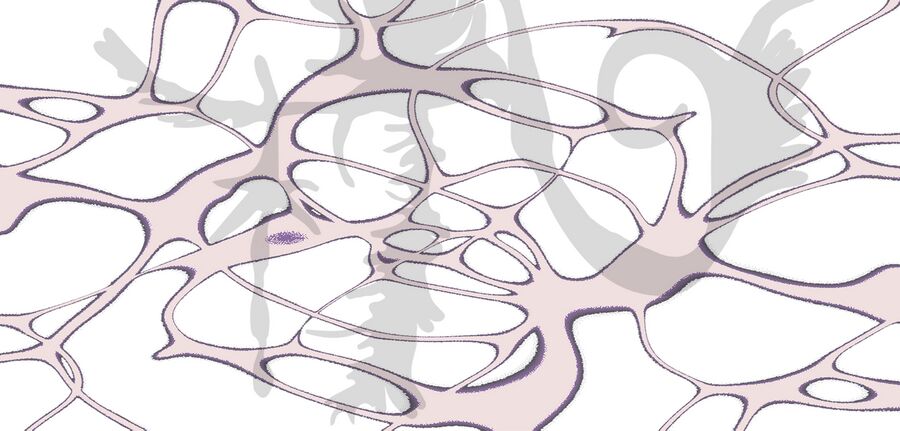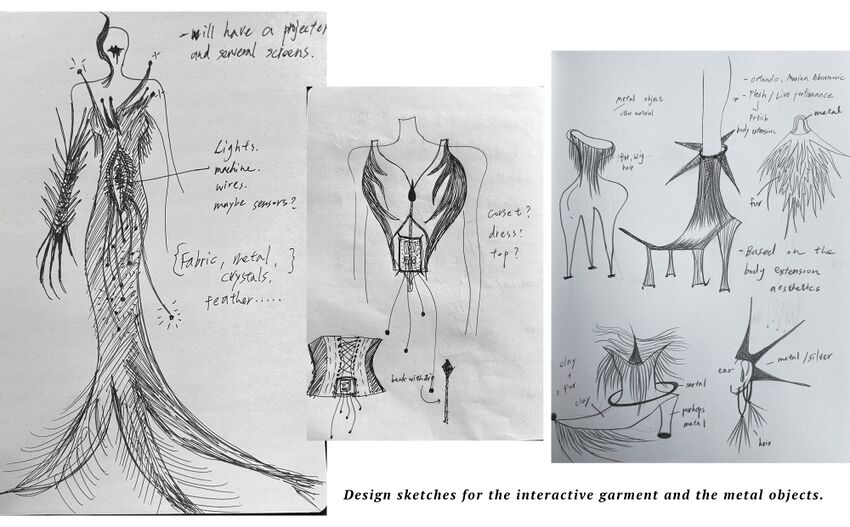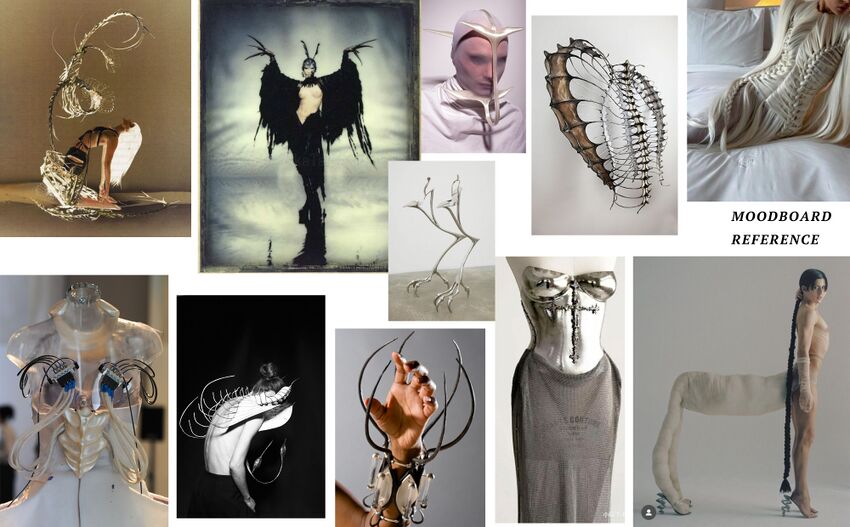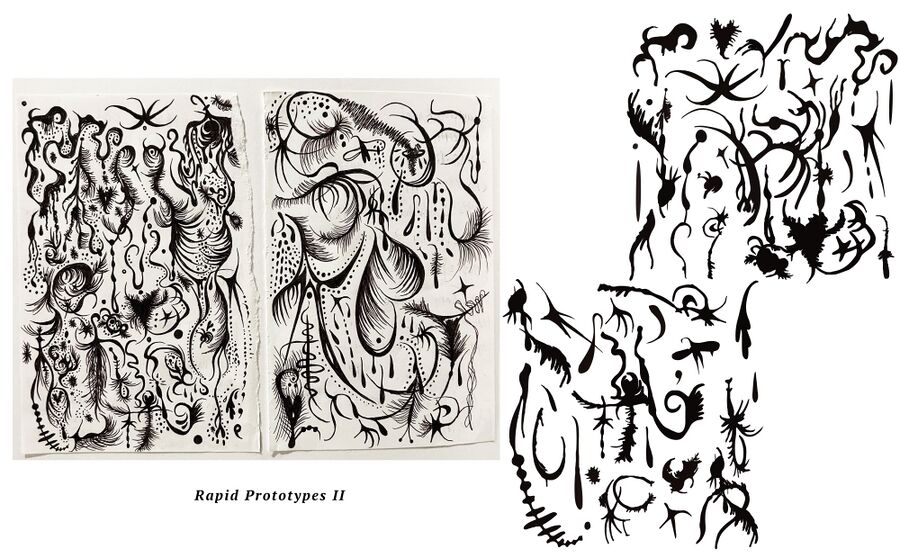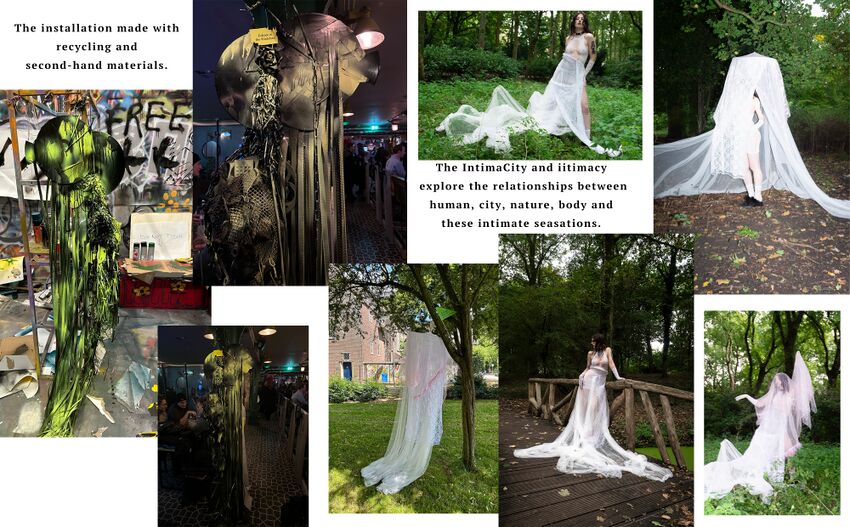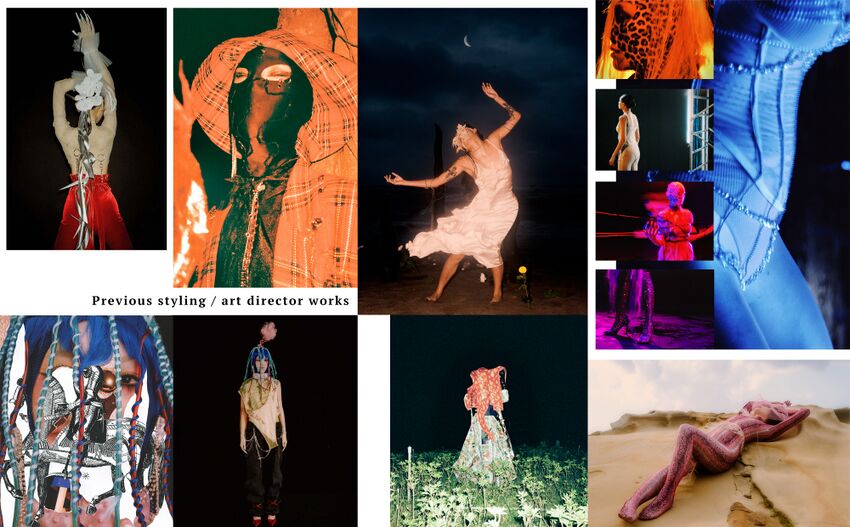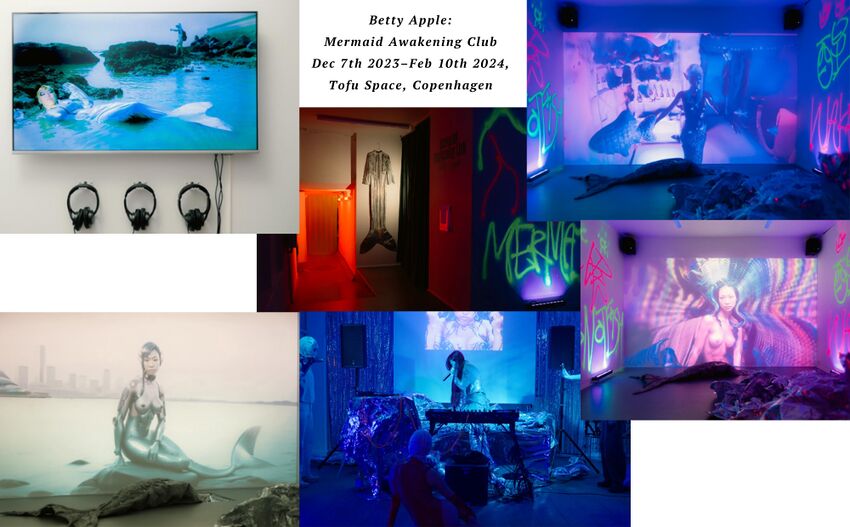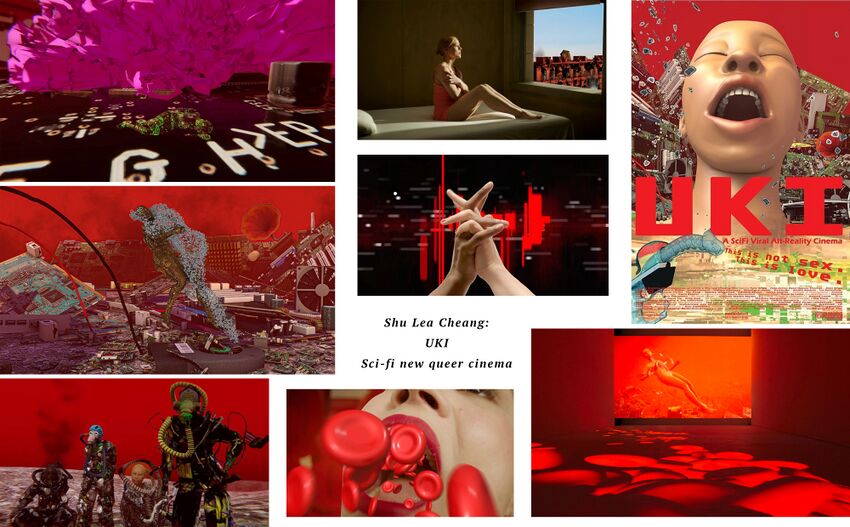User:Michel W/Draft project proposal: Difference between revisions
| (79 intermediate revisions by the same user not shown) | |||
| Line 1: | Line 1: | ||
<div style=" | |||
margin-left: 5%; | |||
font-family: Times New Roman; | |||
font-size:15.5px; "> | |||
==⭑What do you want to make?== | <div style="font-size: 27px; color:#b6789d"> 𝕻𝖗𝖔𝖏𝖊𝖈𝖙 𝖕𝖗𝖔𝖕𝖔𝖘𝖆𝖑 </div> | ||
[[File:Intro image.jpg|900px|frameless|center]] | |||
===<div style= "color:#b6789d";>⭑What do you want to make?</div>=== | |||
I want to create a series of objects | I want to create a series of cyborg-inspired objects and build a new world based in reality that allows for imagining broader possibilities. This work will integrate concepts from cyberfeminism and queer theory, exploring my personal connection with these themes. As someone who identifies as a non-binary queer person, I’m passionate about advocating for these marginalized topics in Taiwan and supporting the community, raising awareness and attention through public events. | ||
In this world, there are no clear boundaries between humans and nature, machines, materials, and animals. The inspiration comes from "Cyborg Manifesto" by Donna Haraway. | In this world, there are no clear boundaries between humans and nature, machines, materials, and animals. The inspiration comes from "Cyborg Manifesto" by Donna Haraway. Imagining a world without gender, which is perhaps a world without origin, but also a world without end. The term "cyborg" is a blend of "cybernetics" and "organism," meaning a semi-mechanical organism. We are all chimeras, hybrids of machines and organisms that are theorized and manufactured; in short, we are all cyborgs. Cyborgs are "born" incomplete, ironic, and full of contradictions, unable to embody any inherent identity. Haraway uses this to create a "plural" rather than "humanistic" utopia. For cyborgs, the construction and deconstruction of boundaries become a daily experience, rather than a theory. | ||
This series will include an interactive fashion garment or art installation. The dress may feature interactive elements, such as sensors embedded in the fabric that connect to software, projecting visuals onto a white wall. To create an immersive experience, the project will also include a 30-minute live performance, inviting the audience to contemplate the following questions: 'Modern queer and gender spectrums have already broken down the traditional binary concept of gender; could there be even more possibilities? Do we still need these or similar myths and metaphors?' | |||
All materials used will prioritize environmental sustainability. Ultimately, the various objects will come together as a cohesive whole, inviting the audience to engage with and explore these questions. | |||
<br> | |||
<br> | |||
[[File:The What.jpg|850px|frameless|center]] | |||
[[File:Mood board.jpg|850px|frameless|center]] | |||
== | ===<div style= "color:#b6789d";>⭑How do you plan to make it?</div>=== | ||
On one hand, I will continue reading and researching more books and articles related to cyberfeminism and queer theory, to explore these topics in depth. I want to discover how to combine the aesthetics of Taiwan and queerness with cyberfeminism to create the cyborg and the world I envision. I hope for more opportunities to connect and learn with the community. In addition to attending exhibitions and events to meet like-minded peers and explore collaboration opportunities, I might organize a workshop on clothing modification and mending. This would invite people to open dialogues as they sew clothes, have communications and ideas exchange. To me, the process of repairing clothes is similar to a healing and regenerative ritual, which between you and the fabric in your hands. I feel that self-healing and regeneration are essential; they acknowledge vulnerability and imperfection while embodying resilience and strength—qualities that resonate with the cyborg concept. The Cyborg Manifesto has opened a door to cyberfeminism, and I want to explore Asian cyberfeminism through this perspective. I believe participating in organizations or communities in Rotterdam or the Netherlands could be a good way to develop the research and opening discourse. | |||
About the prototypes, I will create an interactive garment, mainly using second-hand materials to create a hybrid, regenerative aesthetic. Building on this, I also plan to make wearable or displayable metal objects, such as jewelry or installations. For the garment's interactive elements, I will experiment with connecting Arduino to Touch Designer to project different visual outputs, such as images, text, sounds, and videos. The focus will primarily be on visual elements, so I will collaborate with an artist for sound. My goal is to create an immersive sensory experience for the audience, allowing them to freely explore their personal connections to the themes. From my own experiences, immersive exhibitions and events have always been a source of great inspiration, sparking my curiosity and driving me to get a deeper understanding of the artworks. These thrilling and meaningful moments have guided me a path of personal growth and self-fulfillment. I hope to create unique and memorable immersive experiences in my own projects, inspiring others in the same way. | |||
In relation to my thesis, I want to explore the connections between cyberfeminism, the cyborg concept and aesthetic, and Taiwan/Asian queer communities. The cyborg’s focus on non-binary opposition, the ambiguity of identity and boundaries, and the way queer/non-binary individuals, like cyborgs, liberate gender by transcending binaries—actively embracing a future of diversity, and hybrid identities—is central to this. I also plan to publish a Chinese version of my thesis, with the goal of organizing exhibitions, events, and workshops in Taiwan to connect with the local community. | |||
Moreover, I will also try to achieve gender balance in my references and annotations, aiming for over 80% of my citations come from diverse gender people and women. I hope to contribute in my way to addressing the gender imbalance in academic citations. | |||
[[File:Rapid P 1.jpg|900px|frameless|center]] | |||
[[File:Rapid P 2.jpg|900px|frameless|center]] | |||
===<div style= "color:#b6789d";>⭑Timetable</div>=== | |||
'''September ~ November''' | |||
⊹ Go to different exhibitions, meet new likeminded peers. Search for inspirations. Read. | |||
⊹ Thinking about the possibilities. Discuss the experiences and perspectives with Lien about the queer community in Taiwan. | |||
⊹ Write the project proposal and thesis outline that can help my research. | |||
==⭑Why do you want to make it?== | ⊹ Make prototypes with TouchDesigner and experiment with visual outputs for the public event. | ||
'''December ~ February''' | |||
⊹ Sketch the dress and search for material for it. Make prototypes. | |||
⊹ Make the metal objects. | |||
⊹ Make prototypes with TouchDesigner. | |||
⊹ Write the Thesis and continuing the research. | |||
⊹ Organize the repair workshop in the communities. | |||
'''March ~ April''' | |||
⊹ Arduino + Touch designer prototype. | |||
⊹ Thesis deadline. | |||
⊹ Discuss the collaborations with sound artist and performance artist for the grad show. | |||
⊹ Perhaps another public moment for testing. Trying to reach out to the Asian audiences in Rotterdam. | |||
'''May ~ June''' | |||
⊹ Finish the dress and metal object. | |||
⊹ Do the styling and art director for the final pieces, shooting with a photographer. | |||
⊹ Prepare the grad show. There will be a live performance for 30 mins. | |||
⊹ Rehearse the performance and problem solving. | |||
⊹ Installation and dismantle. | |||
'''Future plan''' | |||
⊹⊹ I am planning to present my graduation project to Taiwanese audiences in Taipei, possibly this year or next. Moreover, I will provide a Chinese version of my research and thesis for more accessibility. | |||
===<div style= "color:#b6789d";>⭑Why do you want to make it?</div>=== | |||
I have always been interested in topics such as feminism, queer theory, gender fluidity, and so on. Exploring these themes has given me a deeper understanding of my own self and gender identity. As someone who identifies as a non-binary queer person, I feel a strong desire to raise awareness of these issues within Taiwanese society and to support the community. My goal is to bring more positive, open, friendly and inclusive future visions for everyone. Furthermore, I plan to present my research through exhibition in Taipei in the near future, also publish it as a book and participate in various public events to encourage meaningful dialogue with Taiwanese communities. | |||
I want to construct a future based on reality that allows for imagining more possibilities. In this envisioned cyborg world, people live in a society and bodily reality where they are unafraid of forming kinship with animals and machines, unafraid of partial identities, or of contradictory positions. This reminds me of the recent advancements in technology, such as AI, and the massive impact of the COVID-19 virus on the world. Our heavy reliance on technology has indeed transformed us into what Haraway describes as "chimeras." | |||
In The Cyborg Manifesto, it’s mentioned that the "sex" of cyborgs revives some of the interesting, nontraditional reproductive methods of ferns and invertebrates. I find this fascinating; cyborgs do not rely on reproductive politics but rather focus on "regeneration", a process of healing trauma and reconstructing the self. For me, self-healing and regeneration are very important because they acknowledge vulnerability and imperfection while embodying resilience and strength. I feel a strong connection to the cyborg through the themes of regeneration, self-healing, and feminine power. | |||
In terms of materials, I am eager to integrate physical and digital mediums. Fashion design, styling and fabric have always been my ways of artistic expression, and now I hope to combine different formats to explore new possibilities and personal practice. | |||
===<div style= "color:#b6789d";>⭑Who can help you and how?</div>=== | |||
⊹ XPUB Tutors: Giving feedbacks for my concepts, Prototyping problem solving. | |||
⊹ XPUB peers: Discussing projects deeply together. | |||
⊹ Nam Wang: Helping me with the Arduino and Touch Designer and giving technical support. | |||
⊹ Metal Station teachers: Giving me technical support with making metal objects. | |||
⊹ Fabric Station teachers: Giving me advice for garment making. | |||
⊹ Lena Chen: Sound artist. There's a possibility to collaborating for the sound outputs. | |||
⊹ Yizon Chen: Jewellery goldsmith/artist who could help me with making handcrafted pieces. | |||
⊹ Tzu Ching Lien: Organizer of Queer crew [https://www.instagram.com/nectar_rrreeuq/ Nectar 瓊漿玉液] in Taipei. | |||
===<div style= "color:#b6789d";>⭑Relation to previous practice</div>=== | |||
The concept of hybridity emphasizes that all things have a spirit, a union of humans and gods, and intimacy with nature. My previous projects, like cyborgs, have liberated gender, broken free from binary-centered oppositions, and actively embraced a future of diversity, heterogeneity, and mixed identities. For example, in the work The Melting Pot, I create the styling and atmosphere of a hybrid non-binary gendered being. A similar aesthetic and collage methods were applied to the post-apocalyptic hybrid art installation in Special Issue 22. | |||
I also focus on creating visuals that challenge conventional standards, opposing mainstream aesthetics. For me, beauty has no single standard, just as gender can be fluid, hybrid, and spectrum-like. | |||
Building on these elements from my previous practices, I hope to establish deeper connections and meaningful exchanges with communities. | |||
<br> | |||
[[File:Previous 01.jpg|850px|frameless|center]] | |||
<br> | |||
[[File:Previous styling.jpg|850px|frameless|center]] | |||
===<div style= "color:#b6789d";>⭑Relation to a larger context</div>=== | |||
I aim to raise awareness of queerness and sharing, discussing and collaborating with the communities. These topics resonate with me because they are a part of my everyday life. | |||
I want to explore the connection between cyberfeminism, the concept and aesthetics of cyborgs, and Taiwan/Asian queer communities. | |||
⊹ Some artworks that inspire and position with my research and practice in a broader field include: | |||
<br> | |||
<br> | |||
[[File:Betty Apple.jpg|850px|thumb|Mermaid Awakening Club (2023)|center]] | |||
⊹'''Mermaid Awakening Club (2023)''' by Taiwanese artist Betty Apple, featuring a 'cyber mermaid' character inspired by Taiwanese culture. Using a near-future science fiction, the work imagines a future global warming that people might combine with AI machines to become 'future mermaids' living back under the sea. It presents a radical recomposition of the world in which the classifications of gender, body, and race are freed within an underwater cyber fantasy. | |||
<br> | |||
<br> | |||
[[File:UKIi.jpg|850px|thumb|UKI (2023)|center]] | |||
⊹ '''UKI (2023)''', a Sci-fi new queer cinema by Taiwanese artist Shu Lea Cheang, challenges male dominated sci-fi cinema by using the genre to articulate queer and anti-colonial perspectives. Cheang’s multidisciplinary works explore the issues of institutional oppression, social inequality, sexual politics and global capitalism. | |||
<br> | |||
<br> | |||
[[File:Johanna Bruckner.jpg|850px|thumb|Our loves are not only human(2020), Molecular Sex & Synthetic Love (2020), Sympoetic Desires Performance (2020)|center]] | |||
⊹ '''Johanna Bruckner’s works (2020)''' also explore the hybridization of humans, animals, and technology, emphasizing queerness and indeterminacy. Her work envisions molecularized and networked worlds where the boundaries between species and technologies blur. | |||
===<div style= "color:#b6789d";>⭑References/bibliography</div>=== | |||
⊹ Haraway, D. (1985). A cyborg manifesto. Victoria, British Columbia: Camas Books. | |||
⊹ Repositorium für die Geschlechterforschung The Cyborg, its Manifesto and their relevance today: Some reflections. (n.d.). doi:https://doi.org/10.25595/115. | |||
⊹ Seu, M. (2023). Cyberfeminism Index. Inventory Press. | |||
⊹ Kirn, P. (2024). _Betty Apple, sci-fi, mermaids, volcanoes, techno, time travel: album + interview - CDM Create Digital Music_. [online] CDM Create Digital Music. Available at: https://cdm.link/betty-apple-interview/ | |||
⊹ U-k-i.co. (2024). _UKI_. [online] Available at: https://u-k-i.co/ | |||
⊹ Damnmagazine.net. (2024). _DAMN Magazine_. [online] Available at: https://www.damnmagazine.net/shu-lea-cheang-uki | |||
⊹ Tofu Collective. (2024). Tofu Collective — Projects. [online] Available at: https://www.tofucollective.com/projects/ | |||
⊹ Johannabruckner.com. (2024). _Johanna Bruckner • Sympoetic Desires, Performance_. [online] Available at: https://johannabruckner.com/work/sympoetic-desires-performance/ | |||
⊹ Johannabruckner.com. (2024). _Johanna Bruckner • Molecular Sex / installation_. [online] Available at: https://johannabruckner.com/work/molecular-sex-installation | |||
⊹ 顧燕翎, 劉毓秀, 王瑞香, 林津如, 范情, 張小虹, 黃淑玲, 莊子秀, 鄭至慧, 鄭美里 (2020). 女性主義理論與流變(完整修訂版). 貓頭鷹出版社. | |||
Latest revision as of 14:00, 22 November 2024
⭑What do you want to make?
I want to create a series of cyborg-inspired objects and build a new world based in reality that allows for imagining broader possibilities. This work will integrate concepts from cyberfeminism and queer theory, exploring my personal connection with these themes. As someone who identifies as a non-binary queer person, I’m passionate about advocating for these marginalized topics in Taiwan and supporting the community, raising awareness and attention through public events.
In this world, there are no clear boundaries between humans and nature, machines, materials, and animals. The inspiration comes from "Cyborg Manifesto" by Donna Haraway. Imagining a world without gender, which is perhaps a world without origin, but also a world without end. The term "cyborg" is a blend of "cybernetics" and "organism," meaning a semi-mechanical organism. We are all chimeras, hybrids of machines and organisms that are theorized and manufactured; in short, we are all cyborgs. Cyborgs are "born" incomplete, ironic, and full of contradictions, unable to embody any inherent identity. Haraway uses this to create a "plural" rather than "humanistic" utopia. For cyborgs, the construction and deconstruction of boundaries become a daily experience, rather than a theory.
This series will include an interactive fashion garment or art installation. The dress may feature interactive elements, such as sensors embedded in the fabric that connect to software, projecting visuals onto a white wall. To create an immersive experience, the project will also include a 30-minute live performance, inviting the audience to contemplate the following questions: 'Modern queer and gender spectrums have already broken down the traditional binary concept of gender; could there be even more possibilities? Do we still need these or similar myths and metaphors?'
All materials used will prioritize environmental sustainability. Ultimately, the various objects will come together as a cohesive whole, inviting the audience to engage with and explore these questions.
⭑How do you plan to make it?
On one hand, I will continue reading and researching more books and articles related to cyberfeminism and queer theory, to explore these topics in depth. I want to discover how to combine the aesthetics of Taiwan and queerness with cyberfeminism to create the cyborg and the world I envision. I hope for more opportunities to connect and learn with the community. In addition to attending exhibitions and events to meet like-minded peers and explore collaboration opportunities, I might organize a workshop on clothing modification and mending. This would invite people to open dialogues as they sew clothes, have communications and ideas exchange. To me, the process of repairing clothes is similar to a healing and regenerative ritual, which between you and the fabric in your hands. I feel that self-healing and regeneration are essential; they acknowledge vulnerability and imperfection while embodying resilience and strength—qualities that resonate with the cyborg concept. The Cyborg Manifesto has opened a door to cyberfeminism, and I want to explore Asian cyberfeminism through this perspective. I believe participating in organizations or communities in Rotterdam or the Netherlands could be a good way to develop the research and opening discourse.
About the prototypes, I will create an interactive garment, mainly using second-hand materials to create a hybrid, regenerative aesthetic. Building on this, I also plan to make wearable or displayable metal objects, such as jewelry or installations. For the garment's interactive elements, I will experiment with connecting Arduino to Touch Designer to project different visual outputs, such as images, text, sounds, and videos. The focus will primarily be on visual elements, so I will collaborate with an artist for sound. My goal is to create an immersive sensory experience for the audience, allowing them to freely explore their personal connections to the themes. From my own experiences, immersive exhibitions and events have always been a source of great inspiration, sparking my curiosity and driving me to get a deeper understanding of the artworks. These thrilling and meaningful moments have guided me a path of personal growth and self-fulfillment. I hope to create unique and memorable immersive experiences in my own projects, inspiring others in the same way.
In relation to my thesis, I want to explore the connections between cyberfeminism, the cyborg concept and aesthetic, and Taiwan/Asian queer communities. The cyborg’s focus on non-binary opposition, the ambiguity of identity and boundaries, and the way queer/non-binary individuals, like cyborgs, liberate gender by transcending binaries—actively embracing a future of diversity, and hybrid identities—is central to this. I also plan to publish a Chinese version of my thesis, with the goal of organizing exhibitions, events, and workshops in Taiwan to connect with the local community. Moreover, I will also try to achieve gender balance in my references and annotations, aiming for over 80% of my citations come from diverse gender people and women. I hope to contribute in my way to addressing the gender imbalance in academic citations.
⭑Timetable
September ~ November
⊹ Go to different exhibitions, meet new likeminded peers. Search for inspirations. Read.
⊹ Thinking about the possibilities. Discuss the experiences and perspectives with Lien about the queer community in Taiwan.
⊹ Write the project proposal and thesis outline that can help my research.
⊹ Make prototypes with TouchDesigner and experiment with visual outputs for the public event.
December ~ February
⊹ Sketch the dress and search for material for it. Make prototypes.
⊹ Make the metal objects.
⊹ Make prototypes with TouchDesigner.
⊹ Write the Thesis and continuing the research.
⊹ Organize the repair workshop in the communities.
March ~ April
⊹ Arduino + Touch designer prototype.
⊹ Thesis deadline.
⊹ Discuss the collaborations with sound artist and performance artist for the grad show.
⊹ Perhaps another public moment for testing. Trying to reach out to the Asian audiences in Rotterdam.
May ~ June
⊹ Finish the dress and metal object.
⊹ Do the styling and art director for the final pieces, shooting with a photographer.
⊹ Prepare the grad show. There will be a live performance for 30 mins.
⊹ Rehearse the performance and problem solving.
⊹ Installation and dismantle.
Future plan
⊹⊹ I am planning to present my graduation project to Taiwanese audiences in Taipei, possibly this year or next. Moreover, I will provide a Chinese version of my research and thesis for more accessibility.
⭑Why do you want to make it?
I have always been interested in topics such as feminism, queer theory, gender fluidity, and so on. Exploring these themes has given me a deeper understanding of my own self and gender identity. As someone who identifies as a non-binary queer person, I feel a strong desire to raise awareness of these issues within Taiwanese society and to support the community. My goal is to bring more positive, open, friendly and inclusive future visions for everyone. Furthermore, I plan to present my research through exhibition in Taipei in the near future, also publish it as a book and participate in various public events to encourage meaningful dialogue with Taiwanese communities.
I want to construct a future based on reality that allows for imagining more possibilities. In this envisioned cyborg world, people live in a society and bodily reality where they are unafraid of forming kinship with animals and machines, unafraid of partial identities, or of contradictory positions. This reminds me of the recent advancements in technology, such as AI, and the massive impact of the COVID-19 virus on the world. Our heavy reliance on technology has indeed transformed us into what Haraway describes as "chimeras."
In The Cyborg Manifesto, it’s mentioned that the "sex" of cyborgs revives some of the interesting, nontraditional reproductive methods of ferns and invertebrates. I find this fascinating; cyborgs do not rely on reproductive politics but rather focus on "regeneration", a process of healing trauma and reconstructing the self. For me, self-healing and regeneration are very important because they acknowledge vulnerability and imperfection while embodying resilience and strength. I feel a strong connection to the cyborg through the themes of regeneration, self-healing, and feminine power.
In terms of materials, I am eager to integrate physical and digital mediums. Fashion design, styling and fabric have always been my ways of artistic expression, and now I hope to combine different formats to explore new possibilities and personal practice.
⭑Who can help you and how?
⊹ XPUB Tutors: Giving feedbacks for my concepts, Prototyping problem solving.
⊹ XPUB peers: Discussing projects deeply together.
⊹ Nam Wang: Helping me with the Arduino and Touch Designer and giving technical support.
⊹ Metal Station teachers: Giving me technical support with making metal objects.
⊹ Fabric Station teachers: Giving me advice for garment making.
⊹ Lena Chen: Sound artist. There's a possibility to collaborating for the sound outputs.
⊹ Yizon Chen: Jewellery goldsmith/artist who could help me with making handcrafted pieces.
⊹ Tzu Ching Lien: Organizer of Queer crew Nectar 瓊漿玉液 in Taipei.
⭑Relation to previous practice
The concept of hybridity emphasizes that all things have a spirit, a union of humans and gods, and intimacy with nature. My previous projects, like cyborgs, have liberated gender, broken free from binary-centered oppositions, and actively embraced a future of diversity, heterogeneity, and mixed identities. For example, in the work The Melting Pot, I create the styling and atmosphere of a hybrid non-binary gendered being. A similar aesthetic and collage methods were applied to the post-apocalyptic hybrid art installation in Special Issue 22.
I also focus on creating visuals that challenge conventional standards, opposing mainstream aesthetics. For me, beauty has no single standard, just as gender can be fluid, hybrid, and spectrum-like. Building on these elements from my previous practices, I hope to establish deeper connections and meaningful exchanges with communities.
⭑Relation to a larger context
I aim to raise awareness of queerness and sharing, discussing and collaborating with the communities. These topics resonate with me because they are a part of my everyday life. I want to explore the connection between cyberfeminism, the concept and aesthetics of cyborgs, and Taiwan/Asian queer communities.
⊹ Some artworks that inspire and position with my research and practice in a broader field include:
⊹Mermaid Awakening Club (2023) by Taiwanese artist Betty Apple, featuring a 'cyber mermaid' character inspired by Taiwanese culture. Using a near-future science fiction, the work imagines a future global warming that people might combine with AI machines to become 'future mermaids' living back under the sea. It presents a radical recomposition of the world in which the classifications of gender, body, and race are freed within an underwater cyber fantasy.
⊹ UKI (2023), a Sci-fi new queer cinema by Taiwanese artist Shu Lea Cheang, challenges male dominated sci-fi cinema by using the genre to articulate queer and anti-colonial perspectives. Cheang’s multidisciplinary works explore the issues of institutional oppression, social inequality, sexual politics and global capitalism.
⊹ Johanna Bruckner’s works (2020) also explore the hybridization of humans, animals, and technology, emphasizing queerness and indeterminacy. Her work envisions molecularized and networked worlds where the boundaries between species and technologies blur.
⭑References/bibliography
⊹ Haraway, D. (1985). A cyborg manifesto. Victoria, British Columbia: Camas Books.
⊹ Repositorium für die Geschlechterforschung The Cyborg, its Manifesto and their relevance today: Some reflections. (n.d.). doi:https://doi.org/10.25595/115.
⊹ Seu, M. (2023). Cyberfeminism Index. Inventory Press.
⊹ Kirn, P. (2024). _Betty Apple, sci-fi, mermaids, volcanoes, techno, time travel: album + interview - CDM Create Digital Music_. [online] CDM Create Digital Music. Available at: https://cdm.link/betty-apple-interview/
⊹ U-k-i.co. (2024). _UKI_. [online] Available at: https://u-k-i.co/
⊹ Damnmagazine.net. (2024). _DAMN Magazine_. [online] Available at: https://www.damnmagazine.net/shu-lea-cheang-uki
⊹ Tofu Collective. (2024). Tofu Collective — Projects. [online] Available at: https://www.tofucollective.com/projects/
⊹ Johannabruckner.com. (2024). _Johanna Bruckner • Sympoetic Desires, Performance_. [online] Available at: https://johannabruckner.com/work/sympoetic-desires-performance/
⊹ Johannabruckner.com. (2024). _Johanna Bruckner • Molecular Sex / installation_. [online] Available at: https://johannabruckner.com/work/molecular-sex-installation
⊹ 顧燕翎, 劉毓秀, 王瑞香, 林津如, 范情, 張小虹, 黃淑玲, 莊子秀, 鄭至慧, 鄭美里 (2020). 女性主義理論與流變(完整修訂版). 貓頭鷹出版社.

